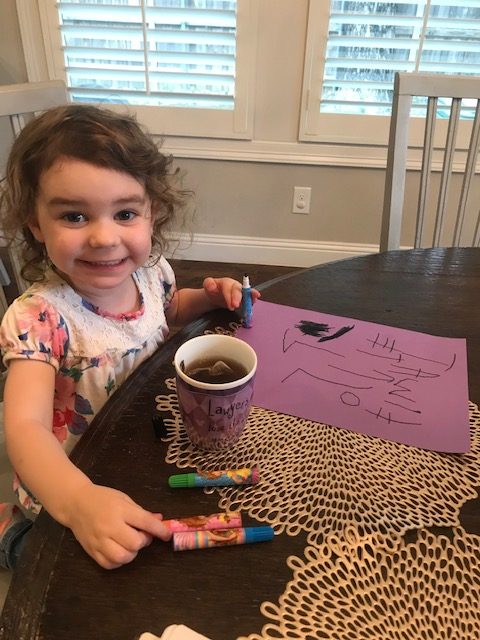It’s a legitimate question for our technology-driven 21st century society.
My answer?
A resounding, unequivocal YES!
Read on to find out why I think EVERY parent – especially every Christian parent – should include handwriting practice in their child’s day.
Communication
While we unquestionably live in a digital world, there are still contracts to be signed, personal cards to be opened, and letters to be written and read.
A mom I met shared a story about her nephew, who received a high school graduation card from his grandmother with a handwritten note at the bottom. Unable to read the cursive handwriting, he passed it to his mother to find out what it said. Shouldn’t an American high school graduate be able to read a note from his grandmother?
Legacy
The original copies of our Founding Documents and great works of literature – even the lyrics for many Beatles songs! – were written in cursive. Some on parchment, others on stationery, and a few on paper napkins! But each is a priceless legacy from the past that enables us to learn, appreciate, and be inspired to make our own contribution to literature, government, and culture. Without the ability to read cursive handwriting, these treasures would be lost.
Love
Do you have a ribbon–tied box of cards and letters from your husband? Is there one on the top shelf of your grandmother’s closet – perhaps containing yellowed envelopes with letters exchanged with your grandfather? Do you sigh when you hear of the thoughtful letters exchanged between John and Abigail Adams, or those written from George to Barbara Bush, Ronald to Nancy Reagan, or even King Henry VIII to Anne Boleyn?
Saved screen shots or printed emails just aren’t the same! Surely there may come a time for all of us when expressing our deepest feelings demands the flowing script of cursive handwriting.
Learning
I think we all instinctively know we tend to remember what we write. But the field of science backs it up. Scientific American says this in an article titled, A Learning Secret: Don’t Take Notes with a Laptop:
“…taking notes by hand forces the brain to engage in some heavy ‘mental lifting,’
and these efforts foster comprehension and retention.”
The subtitle of the article wraps up the study well: “Students who used longhand remembered more and had a deeper understanding of the material.”
For learning and retention, typing notes should never replace handwriting.
If I’ve convinced you of why handwriting is important, you might next ask a legitimate what, when, and how?
What?
Handwriting, like every other discipline, must be practiced to be perfected. Therefore, if kids need to write to become better at writing, why not encourage them to write the Word of God? Why use random, meaningless sentences to practice handwriting when they could simultaneously hide God’s Word in their hearts, as they learn proper penmanship?
When?
Daily is best. Practicing handwriting every day will spur them on to mastery. Ideally, writing the Word each morning when they are learning will prompt a lifetime of writing the Word in a journal as part of their quiet time.
Last summer, I shared a “Write the Word” teaching with some young moms, challenging them to use our Write the Word bookmarks in their own personal quiet time. I was thrilled to receive a text with this sweet photo from one young mom who jumped in the next morning to Write the Word herself – and her precious four-year-old decided to do her own writing the Word with Mommy:

All values and habits are indeed better caught than taught!
How?
The curriculum published by our sponsor, A Reason For, not only provides proper handwriting instruction but lays out each daily lesson in manageable portions. One Bible verse is mastered each week.
A Reason For Handwriting was a joy to our family during our homeschooling years, and I believe incorporating this into your day would be a blessing to your family, as well. You can check out a sample lesson here. The first three levels are designed to practice manuscript, while the last four focus on perfecting a student’s cursive handwriting.
Monday, Tuesday, and Wednesday (Days 1, 2, and 3 of the weekly lesson) are devoted to practicing letters and words that are part of that week’s Bible verse.
On Day 4 (Thursday), students trace over the verse. This not only helps with letter formation but enables children to learn proper spacing between letters within a word, as well as proper spacing between words.
Day 5 is the culmination of the week’s learning. Your child selects a blank Border Sheet (many options are provided in the back of the book), carefully tears it out along the perforated line, and then copies the entire verse in his/her own handwriting. After coloring in the border, it’s time to pray, “Who shall we bless with God’s Word this week?” These Border Sheets have been presented to grandma, delivered to the nursing home, taken to a widowed neighbor, and mailed to missionaries all over the world. The ideas are endless.
While there may be many options for teaching handwriting, I’m convinced A Reason for Handwriting is superior for many reasons:
- Handwriting mastery through daily, incremental lessons
- Scripture is the basis for learning
- God’s Word is hidden in hearts, as it is written by little hands
- Children learn missions and ministry by sharing Scripture
- Children learn the life-long lesson that the very best way to encourage anyone is to share God’s Word
In honor of John Hancock, this Thursday, January 23 (his birthday) has been deemed National Handwriting Day. Why not celebrate by launching daily handwriting – and also committing to take time to Write the Word each day – at your house!
Visit their website for more information about the excellent, scripture-based A Reason For Handwriting program,
and to download sample lessons in every level and free seasonal Border Sheets!

